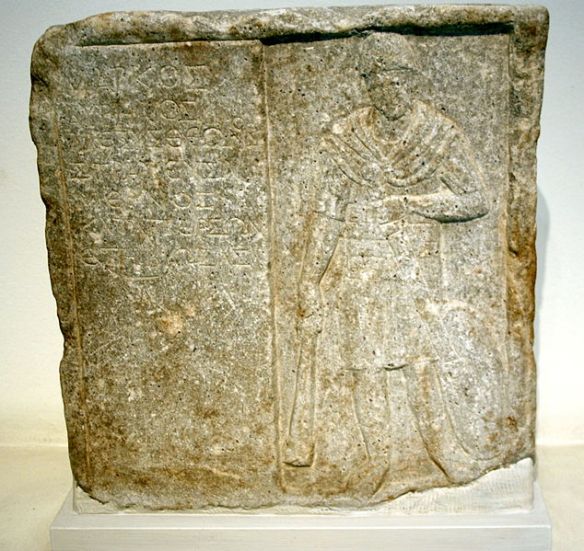A Spartan legionary, Marcus Aurelius Alexys, is member of a cohort recruited by the Emperor Caracalla.
The emperor Caracalla enrolled a cohort from Laconia and Sparta in c. AD 214, for his Parthian war. See Herodian 4.8.3. Alexys unit were employed against Parthian (or Persian – the gravestone actually refers to his death in a Persian War) heavy cavalry in the same way as later Roman clubmen fought cataphracts and clibanarii at Emesa or Singara.
Caracalla also raised a “Macedonian” phalanx. Perhaps the Spartans, were for show and symbolism more than effect. Caracalla becomes both Alexander and Leonidas by leading them. The Spartan clubs might have had no specific tactical function, but were to link them to the tradition of being descendants of Heracles.
#
Elite as in specially raised by the emperor and clearly favoured by him. The club may have been symbolic, but it remains possible that it was a clava intended for use against cataphract cavalry. Compare Zosimus 1.52-53 on the battle of Emesa (AD 272), where Palestinian clubmen are very effective against the heavily armoured Palmyrene cavalry.
Another inscription from Sparta has been restored to suggest that the lochos/cohort was 500-strong and made up of more well-to-do citizens who fought as heavy infantry (Herodian describes it as a phalanx).
But it has also been suggested that Alexys was of lower social status and fought with another Spartan contingent of light infantry. Clubmen necessarily fought in open order so they could nimbly side-step advancing horses and strike riders as they passed, cf. Libanius, Orations 59.110, on the battle of Singara, c. AD 343. Constantine also employed soldiers armed with clubs reinforced with iron knobs to combat Maxentius’ clibanarii at the battle of Turin in AD 312. It would not be surprising to find that Caracalla, who clearly had an interest in specialist fighters (e.g. his problematical Macedonian phalanx, lanciarii and possibly phalangarii and archers in legio II Parthica), had this new unit (or units) equipped and trained to counter Parthian heavy cavalry.
There are several more inscriptions from Sparta recording temporary units that fought in ‘Persian’ wars. At least two date to the Parthian war of Lucius Verus. One may refer to the awarding of dona militaria, indicating a fighting role. True, any Spartan unit would have great symbolism in an Eastern war, but there is no reason that it would be purely symbolic and detached from the fighting.
Earlier in the second century AD, Hadrian created the first Spartan senator, who went on to command a legion. It has been suggested that this was a move to rehabilitate the military tradition of the city. Note also that Spartan contingents fought for Pompey at Pharsalus, and for Octavian at Actium, where the warship of Eurycles attempted to capture Antony’s flagship.
#
Sparta was “burned off” militarily after Eapmeinondas reinstated the Messenians and made Skiritis independent in mid-4th century B. C.
All attempts of later Spartan king to increase the land and hence the warrior number through conquest failed.
Sparta fell to the Romans by the time of Nabis late (Hellenistic period)
Romans created later the KOINON ELEFTHEROLAKONON = commonwealth of free Laconians. Perhaps as a source to raise auxiliary troops.
Romans were recruiting Greeks in the Imperial armies and Spartans were no exception.
